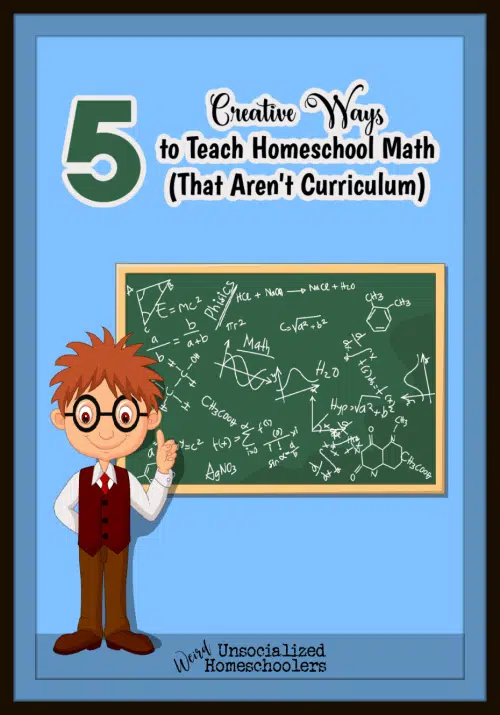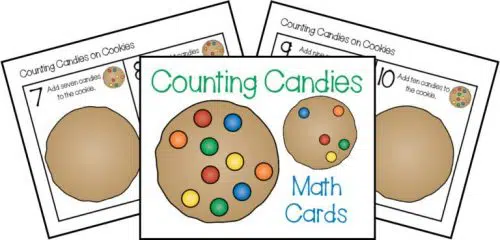5 Creative Ways to Teach Homeschool Math (That Aren’t Curriculum!)
Math…..
Either you love it or you hate it. Rarely is there any in-between. For the math whizzes among us, teaching math to their children is as easy as breathing. They see math everywhere, and making it come to life is something they do almost without effort.
For the rest of us…it can be a struggle.
We agonize over curriculum choices. We read dozens upon dozens of reviews. We compare and contrast. We watch countless YouTube videos of other moms breaking down the pros and the cons of different teaching methods. We ask on Facebook and in our local groups. We don’t trust our own instincts when it comes to figuring out what’s best.
If this is you, maybe it’s time to take a step back and think about how we use math in our everyday lives. When we (and our kids) see math as useful and understand how it applies to almost everything we do each day, it’s easier to see the point in learning it.
Plus, sometimes outside-the-box thinkers require outside-the-box(ed curriculum) teaching methods.
Written by Amy of Real Talk with Amy.
Here are 5 creative ways to teach homeschool math (that aren’t curriculum).
1. Baking
An “oldie but a goodie” in many homeschool circles, baking with kids is definitely a fun (and tasty) way to teach math in a way that’s hands-on and easy to understand. Work with kids on counting, measurements, fractions, time, and more when you get in the kitchen and bake together. Being willing to get your hands a little messy definitely pays off when it comes to helping math concepts “stick.”
2. Shopping
Grocery shopping with kids isn’t always easy, nor is it always fun. Especially in the middle of a pandemic. But, there’s no better way to teach money math than to do it using real products and cold hard cash. If you’re avoiding stores, let kids help you shop online. Together you can make a list, compare prices on different websites, look for coupon codes, and tally up totals.
This is an important life skill you don’t want to skip over.
3. Board Games
Family game nights are a beloved tradition for many – one that offers a whole host of teachable moments. There’s an entire homeschooling trend devoted to this method of teaching. It’s called “gameschooling.” It makes sense. Kids learn best through play. You can cover literally any subject this way depending on the game you choose.
There are many math-specific games that make learning difficult concepts both easy and fun. You can also incorporate math skills into most games by letting your child keep score. If your family doesn’t already have a weekly game night on the calendar, you may want to consider penciling it in.
4. Starting a Business
Do you have a child with an entrepreneurial spirit? Kids like things. Money buys things. Therefore, most kids like money.
Teaching kids to earn their own money and allowing them to buy their own things is a great life skill, but it’s also a great way to teach math. Sit down with your kids and broach the topic. Gauge their interest. If this is something they’d like to explore, brainstorm business ideas with them. Once you hit on a winner, put together a plan of action and get going on it. Then, let them spend some of their hard-earned money.
When kids see how knowing math helps them reach their goals, the lesson hits home far better than any worksheet ever could.
5. Outdoor Play
This applies more to younger kids, but truth be told, ALL kids benefit from time spent outdoors. Really, adults do too.
An afternoon at the park can easily turn into a math lesson without kids even realizing they’re “doing school.”
- Count everything. Leaves, twigs, rocks, swings, sides on a stop sign….count it all.
- Gather a bunch of rocks and arrange them by size.
- Create shapes out of twigs.
- Find pictures in the clouds.
- Grab a compass and figure out which way is due north.
There are so many ways to incorporate math into outdoor play. These are just a few examples to get you started.
Final Thoughts
Math is everywhere. It’s all around us. For the less math inclined (like me), that isn’t always easy to see.
Growing up, I always wondered if the homework I was doing was going to help me in the “real world.” I doubted it would. I was wrong.
I use math every single day. I use math when I’m grocery shopping, paying bills, cooking dinner, and even planning family outings. By being intentional and sharing these insights with our kids, we can show them there is a point to these abstract concepts they’re struggling with. We can make those abstract concepts more concrete by providing real-life examples and giving them hands-on experience.
The list above is just a jumping-off point. How can you make math come alive for your young learners?
Drop your suggestions in the comments below.
You May Also Like:
How to End Math Anxiety in Your Homeschool
5 Ways to Make Math Practice More Fun
Counting Candies on Cookies Math Cards
Amy Thetford is a freelance writer and blogger who homeschools her tribe of tiny humans while pursuing her lifelong dream of becoming a published author. She is fueled by coffee and the desire to do ALL. THE. THINGS. She has the attention span of a squirrel, though she somehow manages to make it through each day with everyone fed and happy (well, mostly happy! Ha!) while striving to make every tomorrow better than the last.








